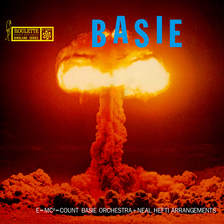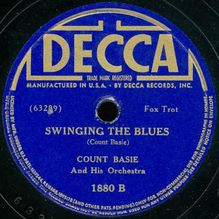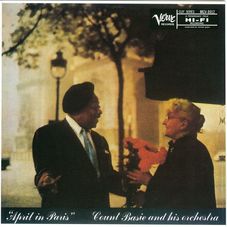| NICK SCHEUBLE |
DRUMMING CONCEPTS & EXERCISES
 Recorded in October of 1957, the Count Basie Orchestra's "Basie" (aka E=MC2), Roulette 500001, is widely regarded as one of the greatest Big Band recordings ever made. Sonny Payne is playing beautifully throughout-no surprise there-he was one of the most swinging and slick drummers ever! This is a transcription of the first tune on the record, "The Kid from Redbank" which refers to Basie, himself, and features Basie's virtuosity at the piano. It's uptempo and the band is super tight with Sonny in the driver's seat. Of note: Sonny plays hi-hat time throughout, masterfully altering the spread, or lack thereof, of the hats according to the ensemble or solo piano sections. There's lots of phrasing in "3" by Basie and Sonny within the 4/4 framework which marries these same hemiola figures written in the arrangement by Neal Hefti.
0 Comments
 "Swingin' the Blues" Count Basie and his Orchestra, February 16,1938 Decca 1880 Papa Jo Jones, drums This is a transcription of Papa Jo Jones' drumming on "Swingin' the Blues." Of Note: As with many of my big band transcriptions, I only notated the bass drum when I could hear a variation or accent. Otherwise, please assume the bass drum is feathering four beats to the bars when the bass player is walking. Nick Scheuble, 2018
 On July 26, 1955, The Count Basie Orchestra documented a historic performance of "April in Paris" (Verve Records; MG V-8012 Master 235 Take #1). 29 year old Sonny Payne is the incredibly swinging drummer on that recording. This is a transcription of Sonny's drumming on that date. Of Note: Like most big band drummers of this period, Sonny played the bass drum lightly on all four beats (feathering) when the bass played walked, and played the hi hat on 2 & 4 (with the foot). For this transcription, I only notated the bass drum when I could hear a variation or accent (with the exception being when I notated the basic role the bass drum and hi hat; the start of line 3 and line 7, for example). Nick Scheuble, 2018
The Left hand Development Exercise (ala Joe Morello) The Left hand Development Exercise (ala Joe Morello) is pretty much self explanatory. I’ve written continuous 8th note triplets with the accent on the last note of each triplet to be played solely by the Left hand. The Right hand occasionally fills-in making various combinations of 16th note triplets. The first two bars act as both an intro and an interlude between exercises (see instructions at top right of the exercise). The information at the left top of the page is simply to give an indiction of how long it will take to go through this exercise at various tempos once the exercise is mastered. That last word, "mastered", is important because, as with all exercises, care should be taken that exercises are not rushed through but instead, practiced carefully with a relaxed feeling. The purpose of this exercise is to give the left hand a workout and place it in a dominant rhythmic position in the music (left hand lead). Please note that this exercise is geared toward right handed players. Left handed drummers should simply reverse the sticking for the same effect.
Hi Hat Independence: The 4th Limb I’ve written twenty-four triplet based exercises that utilize the standard jazz ride cymbal rhythm along with linear patterns between the snare drum and bass drum. The eight hi-hat rhythms (A-H) are meant to be practiced along with each of these exercises. You may choose to practice Letter “A” along to all 24 exercises before moving on to letter “B”, or practice letters A through H to exercise # 1 before moving onto exercise #2. This is entirely up to you. Other routines are also possible and should be explored. I would recommend making sure that you are able to repeat each exercise many times in succession in a relaxed manner with a good “feel” before considering an exercised “mastered”. Also, it’s a good idea to practice these at various tempos, and possibly, at least some of the time, to a metronome. In doing so, you will be gaining greater flexibility, removing some physical restriction and allowing creative thoughts a better chance of being realized. Have fun!
Notes on “Counting the Phrase” by Nick Scheuble “America” from “West Side Story” makes use of a hemiola whereby two groups of three can also be phrased of as three groups of two (1, 2, 3 / 1, 2, 3 /1, 2 /1, 2 / 1, 2). The idea of phrasing in groupings outside of a specific subdivision (or time signature) can yield very interesting musical results. But with that said, I believe that sometimes we may be deceiving ourselves into thinking that we are hearing these shapes when in fact, we may only be adhering to accents within the prescribed time signature or subdivision. To truly hear these shapes as they exist in and of themselves regardless of time signature or subdivision is the purpose of these exercises. I’ve developed a handful of rhythmic exercises that can help in developing this sensitivity. In the first example, I’ve written out a measure of accented triplets counting in a traditional way: 1+d, 2+d, 3+d, 4+d (one, an-da, two an-da etc.). Then I wrote an alternate counting based on the phrases. These rhythmic phrases are five note phrases. In this case, “1,2,3,4,5” replaces “+d, 2+d and so on. Later, I wrote seven note phrases. Again, it may be helpful to first count the measures as accented groups of triplets (“1+d, 2+d” etc). However, the goal here is to ultimately count in groups of seven (“1,2,3,4,5,6,7”) The last set of exercises are to be played against a shuffle “time”. If the player is right-handed and normally plays the ride cymbal with his or her right hand, the left hand should play the 2 written exercises on the snare using the left hand. While these last couple of exercises may easily be seen as derived from a half note triplet grouping in 4/4 time, it is again advisable to try to count the 4 note grouping that I’ve written. Lastly, these are only ideas to get you started. Please experiment with counting and “feeling” other phrase groupings. Have fun! Nick
While this is not a drumming concept or exercise, it is nevertheless a very interesting article relating to the death of one of the greatest jazz trumpeters of all time, Lee Morgan
One of the great things about be-bop was it’s use of asymmetrical phrases. Lots of 3/4 phrases within the 4/4 structure can be found in the music of Charlie Parker (think of “Billie’s Bounce”) or Monk (“Straight, no chaser”). In fact, in his solos, Max Roach often phrased two bars of 4/4 as two 3/4 phrases followed by one 2/4 phrase. As jazz modernized, this practice has been explored even more. I adapted the material from my previous blog (exercise #4: “The Double Time Fill” ) to prepare these exercises. Here I take four note groupings of sixteenths and place them over a series of triplets. The resulting asymmetry is really interesting. You can experiment with this idea further by simply taking any four note motif and superimposing it over a series of triplets -The concept of “paratriplets” (if you’re familiar with those) uses the same principle. Or you can go the other way and take what was ordinarily a three note motif and place it over a four note grouping. The possibilities are endless, so I’ll probably write some more stuff along these lines for future blogs. In the meantime, Have fun!
Performing a dense , fast paced fill coming from a slow or half speed groove can “energize” the music and be exhilarating for the listener. But it’s not usually easy to do-especially if the tempo is really slow. This exercise pairs two different grooves (a basic jazz groove and a half time rock groove) to be practiced along with various 16th note fills. The syncopated nature of these fills along with the speed of each figure when compared with the sparse groove, may be a bit tricky to pull off. But keep at it. These really sound great!
Please Note that the Grooves at the top of the page are labelled "Beat one' and "Beat two". I realize this can be confused with the count and should've been labelled "Groove one" and "Groove two". please take note. Thank you.
|
||||||||||||||||||||||||||||||||||||||||||||||||||||||||||||||||||||||||||||||||||||||||||||||||
© 2017 All Rights Reserved - NickScheuble.com